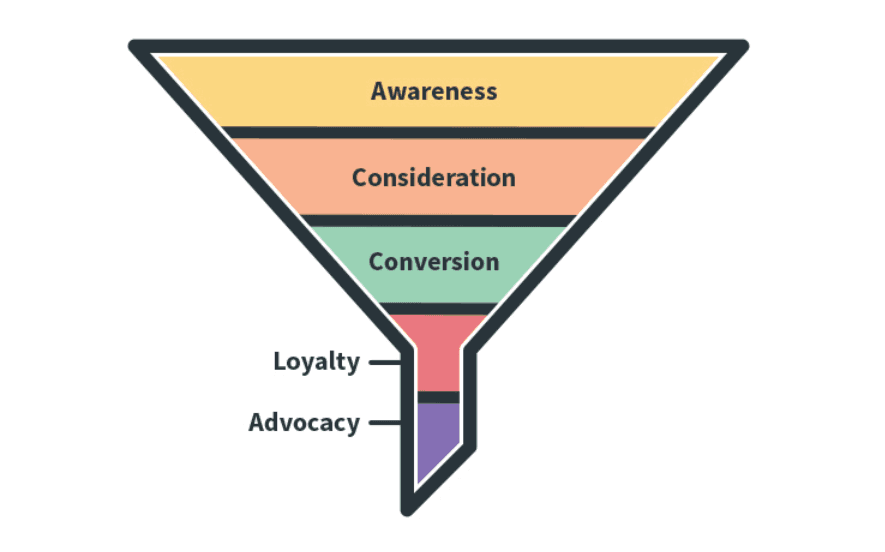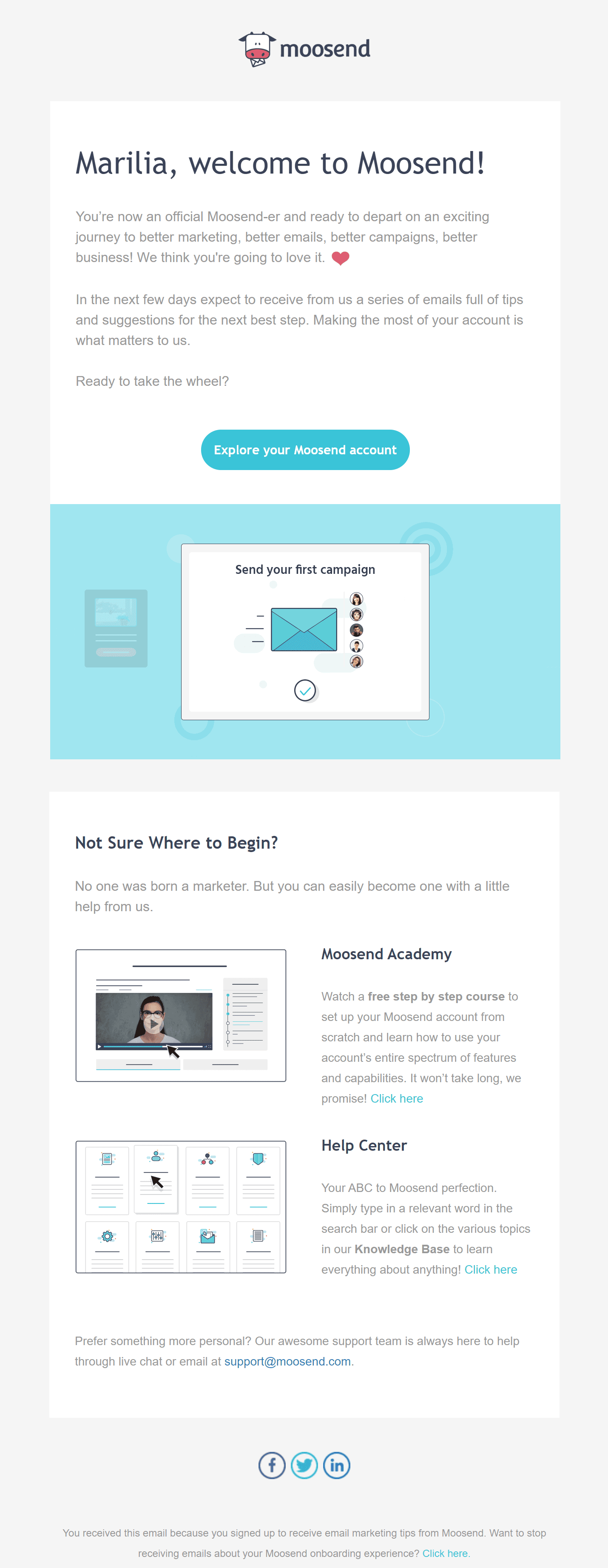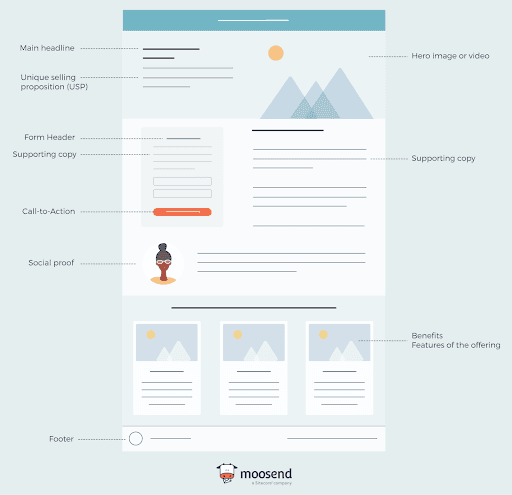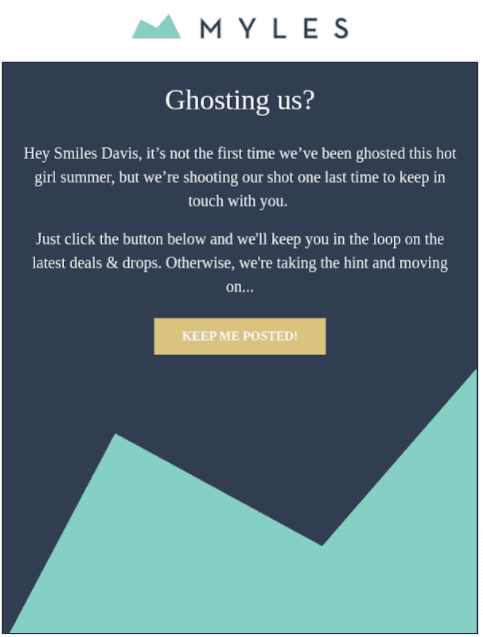3 Steps to create and master an email marketing funnel
Dec 20, 2022
Published by: Alex Souchoroukof

In 2022 email remains one of the most effective ways to nurture your leads and convert them into paying customers. Half of the world’s population uses email, or if you’re more number-driven, 4.3 billion people.
If you’re not into email marketing, your business loses revenue every day. The best time to start with this strategy is yesterday, so fasten your seatbelts because, in this article, we’ll analyze how to create and master an email marketing funnel.
What is an email marketing funnel?
An email marketing funnel depicts the four stages of a customer's journey as it relates to email. The funnel starts with product awareness, progresses to consideration and ends with the conversion and loyalty stage.

The different phases of an email marketing funnel
The email content is crucial for each phase of the funnel and can drastically improve the overall success of your strategy. You can optimize the user experience and give targeted, relevant content to your audience as they complete the buyer journey.
More importantly, if you’re into email marketing for small businesses, ensure a solid funnel to guide your potential customers to take the next step.
Awareness Stage
The first stage of the email marketing funnel helps increase raise brand recognition. Unless your organization has a solid brand name, potential buyers at the top of the email marketing funnel are still learning about your company, so detailed, product-specific content will overwhelm them.
To improve your chances of reaching a large mass of potential customers, you can leverage blog posts, link-building, social media or incentivize to grab your audience's attention.
Your emails should contain instructional information at this level to demonstrate value, promote your organization as a thought leader and build a relationship with potential clients.
Consideration Stage
A successful email marketing campaign grabs attention with awareness and attempts to close the deal with consideration content.
After making an initial connection with awareness content, potential buyers should be intrigued enough to seek more information. If you showcase how the product or service will help them, potential customers will start to understand how it works and will consider if it fits their individual needs.
Use webinars or original case studies that highlight your competitive advantage. In this phase, a video could work better than other mediums as it can convey the full picture of your brand and encourage people to consider your offer.
Include this information in your emails, or include links to your website so that potential consumers can learn more about your brand. Make them feel as if they can't live without your products or services.
Focus on answering pain points that your audience has and put yourself in the position of a potential customer and think about what you'd want to hear.
In the following email for example Moosend highlights the Moosend Academy with which potential customers can educate themselves before taking the extra step.

Conversion Stage
The conversion stage is the most vital phase in the email marketing funnel. If you've done your job well, the content of your email will lead to the customer making a purchase.
This stage is vital as it's a fine line between persuading customers to buy your product and instilling a sense of urgency. Offer a discount, free shipping or another buying incentive to make the transaction more likely.
Increase conversions by making the purchasing process as simple as possible. You can do the following:
Remove any unnecessary steps that divert the user from purchasing
Incorporate a call to action button into your email
Ensure that the email has the same aesthetics and brand voice as your landing page
Loyalty Stage
After someone makes a purchase, continue cultivating the relationship by providing them with helpful information or targeted offers.
Send follow-up emails with workshops or tips on getting the most value from the product to keep your consumers engaged. This phase in the email marketing funnel aims to confirm the customer's choice to purchase your goods and maybe persuade them to do it again.
A successful email campaign is defined by getting customers to recommend a product. If you've succeeded in persuading your customer to buy, the next step is to turn them into brand ambassadors and share referrals about your brand.
When delighted customers feel strongly about a product or business, they leave positive reviews or share their recommendations with friends.
Inject life into your existing email list
Check out this episode of The Lucky Orange Show to learn from Customers.ai CEO Larry Kim on getting the most out of your existing email list.
How to create an email marketing funnel
Crafting successful email marketing funnels requires trial and error. You need to understand your data and pivot towards practices that work best for your kind of brand. Let’s now see how to build your next successful email marketing funnel.
Build your email list
Building a list is the foundation of every successful email marketing funnel. To craft a high-converting email list, you can follow the strategies below:
Landing Pages
A landing page is maybe the most popular tool to help you create an email list. You first need to set a clear goal and then select a landing page template.
If you are not familiar with templates or don’t know how to create one, many landing page builders can make your life easier and have a solid high-converting page as a starting point. Here’s a typical landing page layout to keep in mind when building your own.

Conversion Stage
The conversion stage is the most vital phase in the email marketing funnel. If you've done your job well, the content of your email will lead to the customer making a purchase.
This stage is vital as it's a fine line between persuading customers to buy your product and instilling a sense of urgency. Offer a discount, free shipping or another buying incentive to make the transaction more likely.
Increase conversions by making the purchasing process as simple as possible. You can do the following:
Remove any unnecessary steps that divert the user from purchasing
Incorporate a call to action button into your email
Ensure that the email has the same aesthetics and brand voice as your landing page
Loyalty Stage
After someone makes a purchase, continue cultivating the relationship by providing them with helpful information or targeted offers.
Send follow-up emails with workshops or tips on getting the most value from the product to keep your consumers engaged. This phase in the email marketing funnel aims to confirm the customer's choice to purchase your goods and maybe persuade them to do it again.
A successful email campaign is defined by getting customers to recommend a product. If you've succeeded in persuading your customer to buy, the next step is to turn them into brand ambassadors and share referrals about your brand.
When delighted customers feel strongly about a product or business, they leave positive reviews or share their recommendations with friends.
How to create an email marketing funnel
Crafting successful email marketing funnels requires trial and error. You need to understand your data and pivot towards practices that work best for your kind of brand. Let’s now see how to build your next successful email marketing funnel.
Build your email list
Building a list is the foundation of every successful email marketing funnel. To craft a high-converting email list, you can follow the strategies below:
Landing Pages
A landing page is maybe the most popular tool to help you create an email list. You first need to set a clear goal and then select a landing page template.
If you are not familiar with templates or don’t know how to create one, many landing page builders can make your life easier and have a solid high-converting page as a starting point. Here’s a typical landing page layout to keep in mind when building your own.
Once your subscribers are on your list, webinars allow you to communicate with them on a more personal level. To make a more valuable webinar, enable subscribers to ask questions before, during and after the presentation.
Find your Ideal Email Marketing Platform
Email service providers (ESP) wrapped inside marketing platforms allow you to send email campaigns to your prospects. Some have evolved into all-in-one marketing and sales tools that may assist you in creating complicated funnels in addition to sending marketing emails.
Here’s what you need to consider if you're trying to figure out which email marketing software is best for your team.
Library with email templates
Most tools provide a large number of templates to choose from. As a marketer, you need to decide how much you'll rely on pre-made templates and how much customization you'll want to make.
If you’re not a developer or graphic designer, Moosend offers a wide variety of email templates that will eliminate every friction point as most elements can be changed with a drag-and-drop builder.
Automation
An excellent email marketing software has the tools to create automation campaigns that run on autopilot after you schedule them.
You can create automation for onboarding sequences, cart abandonment and many more user behaviors that guide potential customers from one stage of the funnel to another one.
Mobile-friendly
All of your marketing, including your emails, should be mobile-friendly. Choosing a platform that enables you to build and preview your campaigns on mobile easily is a huge advantage for email marketers.
Reporting and data management
The ability to view how many subscribers you have, where they are in the funnel and how they’re converting at various phases of the funnel are just a few of the reasons why you should make sure the platform has a straightforward dashboard environment.
Having a tool that provides a plethora of information for your campaigns is vital because you can pivot your strategies based on data-driven decisions.
Create a High-converting Email Funnel
Now that you have a solid foundation for crafting your first email marketing funnel let's look at how to increase conversions.
To do that, you should aim to:
Improve the quality of your leads by nurturing them more effectively
Improve your results by analyzing and optimizing your strategy
Reduce the time that is necessary for a lead to become a customer
A well-crafted email, regardless of whether it's automated or not, makes your subscribers feel good about their decision to join your email list, which is why you should consider the value you provide to each campaign.
Try to send a friendly and welcoming email to your new subscribers, or use your email marketing tool to automate autoresponders, follow-ups, reminders and sales emails.
Automated welcome email
When someone joins your email list, you must provide the best onboarding experience possible. It's the start of their road to becoming loyal clients or brand evangelists.
Take the time to craft a welcome email that shares valuable resources, your brand’s culture and lets them know what to expect next.
The best part is that you can set a trigger and send automated sequences that do the work for you. There are many great welcome email examples online that can help you get the feel of what works in this kind of situation.
Your welcome email is an excellent tool in your arsenal to start building that long-term rapport with your customers, so don't underestimate it.
Automated follow-ups
Follow-up emails are an excellent strategy for building a stronger rapport with your customer base and converting them into loyal buyers.
Begin with a personalized subject line that catches the reader's attention while also reminding them of previous interactions with you: "Alex, we've missed you."
If you're trying to clean up your email list, this is a fantastic way to determine which recipients don't open your emails and should be removed. Hunter provides a wide variety of follow-up email examples for you to take some inspiration and craft your emails in your brand’s voice.
Keep in mind that with several email marketing tools like Moosend, you can target non-openers and send campaigns again with slight changes on your campaigns to make them engage.
Automated re-engagement emails
From time to time, you'll have to face a drop-off in engagement. To ensure that you always have a loyal audience, consider including a "check-in" message or asking for comments on your product or service to encourage contact.
A special discount or promotion can sometimes be the deciding factor for such users, providing them the final push they need to return to your funnel. Here’s what a re-engagement message might look like:

Also, remember that re-engagement campaigns are an excellent way to test new elements and CTAs because these consumers would otherwise abandon your funnel.
Re-engagement campaigns are a win-win scenario where you don't have something to lose. Keeping your email list fresh will ensure a high-converting funnel that is crucial for increasing your revenue.
The Takeaway
Email marketing allows for an incredible amount of personalization and customization. If you have the time and a little imagination, you can create an email marketing funnel that accomplishes almost anything.
While writing such emails may appear to be a lot of work at first, consider how these messages may be automated over and over again, allowing you to put your email marketing campaigns on autopilot while you focus on your business.
Combined with clean email lists, you have the necessary tools to skyrocket your growth and increase revenue upon 2022. So what are you waiting for?
Start building your next email marketing funnel, and until the next one, keep sending emails.




